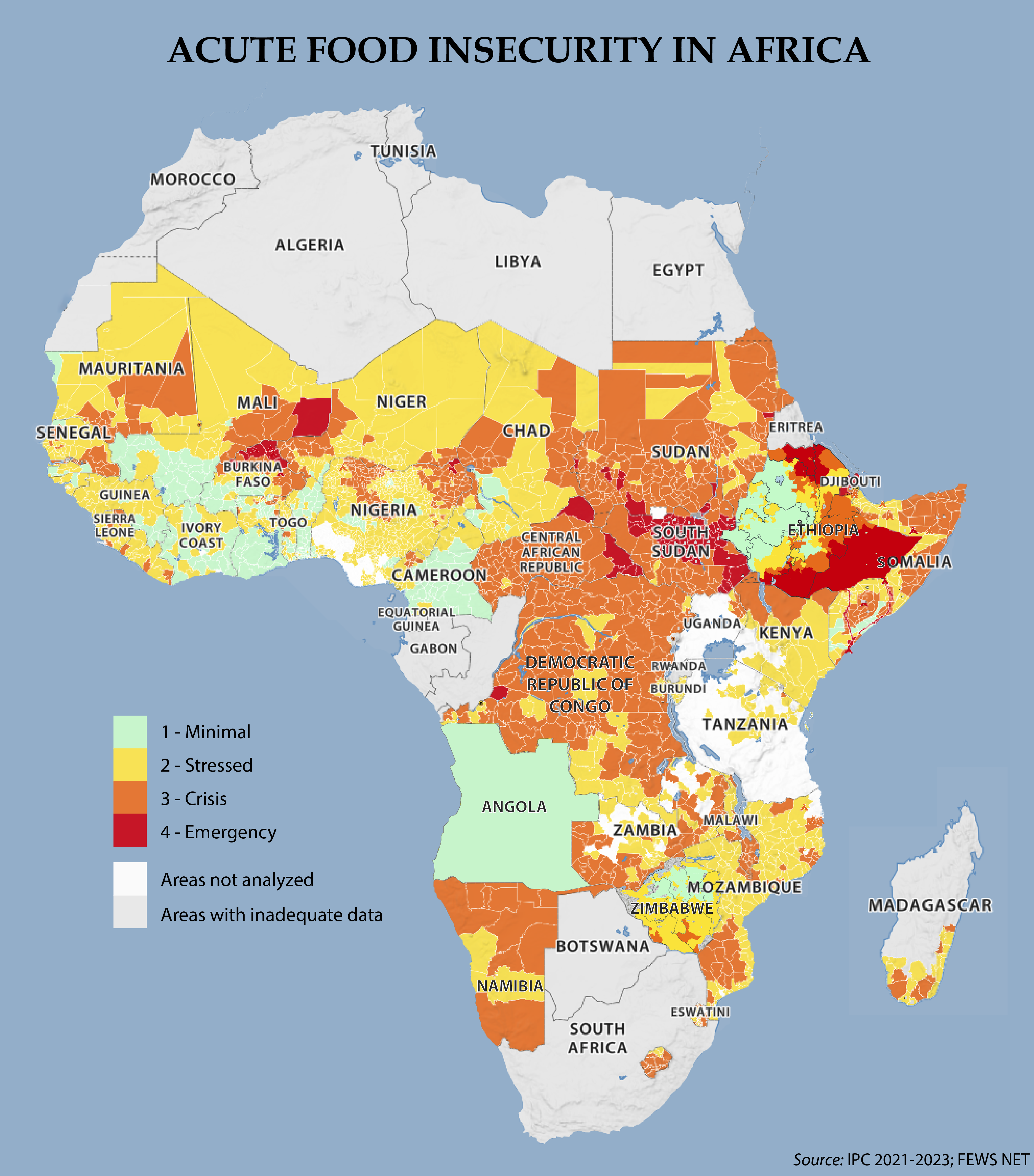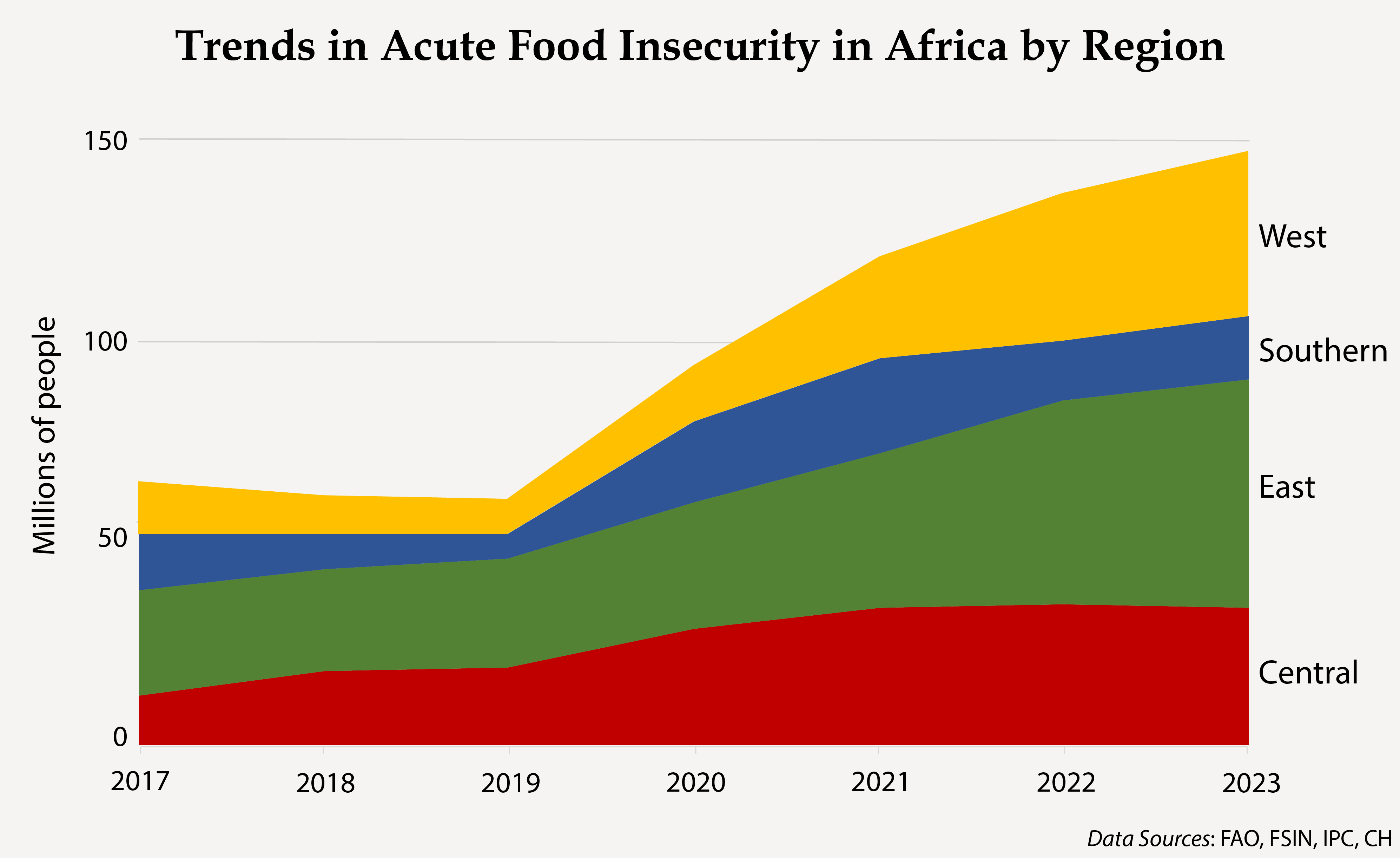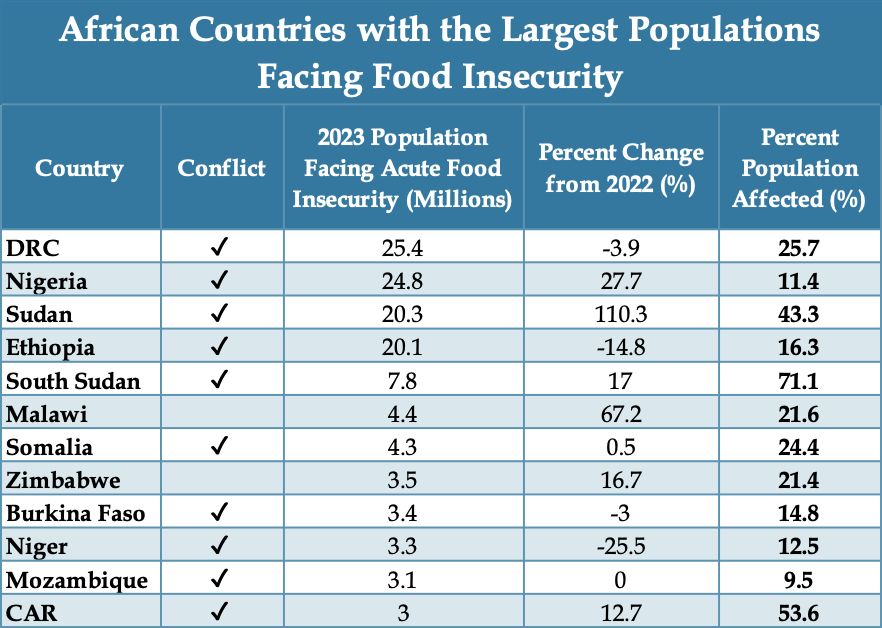
Click here for a full-size map.
Highlights
- An estimated 149 million Africans are facing acute food insecurity—an increase of 12 million people from a year ago. This equates to a risk category of 3 or higher (Crisis, Emergency, and Catastrophe) on the Integrated Food Security Phase Classification (IPC) scale of 1 to 5.
- Some 122 million of those facing acute food insecurity are in countries experiencing conflict—82 percent of the total—accentuating that conflict is the primary driver of acute food insecurity in Africa.
- 8 of the top 10 African countries experiencing acute food insecurity are facing conflict.
- The 149-million-person figure represents a 150-percent increase in the number of Africans facing acute food insecurity since 2019 when 61 million people were in this category.
“[There has been] a 150-percent increase in the number of Africans facing acute food insecurity since 2019.”
- This highlights the compounding humanitarian effects of Africa’s unresolved conflicts.
- While 38 African countries are experiencing some level of acute food insecurity, roughly two-thirds of this threat is concentrated in five countries: the Democratic Republic of the Congo (DRC), Nigeria, Sudan, Ethiopia, and South Sudan—all of which are conflict-affected.
- Nearly all of the continental increase in acute food insecurity in the past year was a result of the eruption of conflict in Sudan and a deterioration of security in northern Nigeria.
- Four of the top 10 countries facing the most acute food insecurity are in East Africa—Sudan, Ethiopia, South Sudan, and Somalia.
- 19 African countries have at least 10 percent of their populations facing acute food insecurity.
- Conflict compounds the impacts of other external shocks like climate change, inflation, and the disruption to global grain supplies caused by Russia’s invasion of Ukraine. Moscow’s withdrawal from the Black Sea Grain deal that enabled 33 million MT of grain to reach global markets and lower food prices, especially in Africa, has further worsened the food outlook.
- Historically, El Niño climate patterns, which have now returned, have historically led to decreased precipitation in Southern Africa, Western Africa, Sudan, and Ethiopia.
- There have already been fatalities due to hunger reported this year in Ethiopia and Somalia. WFP has predicted that before year’s end, 129,000 people are expected to experience Catastrophe levels (IPC 5) of hunger in Burkina Faso, Mali, Somalia, and South Sudan. A rapid scale-up of assistance has averted even more people facing starvation.
Following is a look at some of the African countries with the largest populations experiencing acute food insecurity.
Democratic Republic of the Congo
Approximately 25.4 million people in the DRC are experiencing Crisis levels or higher food insecurity, including 3.5 million experiencing Emergency levels. The most affected are displaced and host families living in conflict zones. The first half of the year saw a significant escalation of fighting between armed groups, causing an unprecedented displacement of 1 million people. There are currently 5.8 million internally displaced people due to conflict. Another 1 million are living outside of the country, the majority in neighboring countries Tanzania, Uganda, and Rwanda.
Food prices have also increased significantly, impacting the poorest populations in urban and peri-urban areas as well as isolated areas.
Nigeria
An estimated 24.9 million Nigerians are facing Crisis or higher hunger, including 1.1 million at Emergency levels. Another 4,000 people were expected to fall into Catastrophic conditions in the June to August 2023 period, but due to a lack of data the estimate could not be verified.
According to the FAO, humanitarian access constraints remain very high, particularly in Borno, Yobe, and Adamawa due to the ongoing violence related to militant Islamist groups Boko Haram and Islamic State in West Africa.
Sudan
“Conflict and economic collapse have driven over 43 percent of the country’s population into high levels of acute food insecurity.”
Conflict and economic collapse have driven about 20.3 million Sudanese (over 43 percent of the country’s population) into high levels of acute food insecurity, between July and September 2023. Of those, almost 6.3 million people (13 percent of the population) are experiencing IPC Phase 4 (Emergency) levels of food insecurity. The populations with the highest food insecurity are in locations and states experiencing active conflict, including Darfur, Khartoum, and Kordofan.
Both the Rapid Support Forces (RSF) militia and the army have been accused of looting and aid diversion despite commitments they made to facilitate humanitarian assistance. The RSF has also been accused of employing siege tactics in Khartoum to deny civilians access to food and other necessities in violation of international humanitarian law.
Ethiopia
An estimated 20.1 million people are facing food insecurity in Ethiopia, and 15.1 million require emergency food assistance, following a 2-year war in Tigray, conflicts in other parts of the country, as well as a severe drought that struck the Horn of Africa. The World Food Program and other donors suspended food aid in Ethiopia for 4 months following the discovery of a large-scale diversion within the country.
“Around 5.4 million of Tigray’s 6 million population rely on humanitarian aid.”
Researchers found that at minimum, 1,300 people have died from starvation in northern Tigray since the end of the hostilities, the numbers increasing dramatically since the suspension of food aid. Around 5.4 million of Tigray’s 6 million population rely on humanitarian aid.
South Sudan
In South Sudan, 7.8 million (71 percent of the population) faced Crisis and above levels of hunger this year. This number included 2.9 million people facing Emergency levels of hunger countrywide and 43,000 facing Catastrophe levels in the state of Jonglei.
The situation is being driven by rising levels of violence and insecurity as well as “chronic vulnerabilities worsened by frequent climate-related shocks (severe flooding and dry spells), the macro-economic crisis, and low agricultural production.”
Since the outbreak of the Sudan conflict in April this year, almost 293,000 South Sudanese returnees and Sudanese refugees have entered South Sudan. This influx is exacerbating the already severe humanitarian situation in South Sudan, placing additional strain on limited humanitarian resources and escalating food and fuel prices.
Malawi
Malawi—one of only two African countries among the top ten facing the highest levels of acute food insecurity not experiencing conflict—has long faced chronic food shortages. This year, approximately 3 million people (15 percent of the population) are experiencing Crisis levels of food insecurity. That number is expected to increase to 4.4 million (22 percent of the population) in the coming months as Malawi deals with the effects from extended droughts, cyclones (such as Tropical Cyclone Freddy), and floods—leading to below-average crop production. High food prices and low purchasing power, due to the 25-percent devaluation of the Malawi kwacha and Russia’s invasion of Ukraine, have also contributed to the increases.
Somalia
“Somali communities most impacted by acute food insecurity live in areas either cut off or contested by the militant Islamist group, al Shabaab.”
Somali communities most impacted by acute food insecurity live in areas either cut off or contested by the militant Islamist group, al Shabaab. An estimated 43,000 people died from starvation in 2022. Potentially another 18,000 to 34,000 have perished in the first half of this year. After five consecutive failed rainy seasons, the cycle was broken with the rains in April through June. Nonetheless, nearly 4.3 million are expected to continue to experience Crisis and above levels of food insecurity, including 1 million facing Emergency levels.
The number of internally displaced across Somalia is estimated to be at least 3.8 million, including almost 1.5 million newly displaced this year due to conflict, the drought, and floods. With the government and allied communal militias still battling al Shabaab forces and humanitarian aid donor fatigue setting in globally, Somali citizens can expect continued instability and high levels of food insecurity.
Burkina Faso
In Burkina Faso, an estimated 3.4 million people, or 15 percent of the population, faced Crisis or worse levels of acute food insecurity between June and August 2023. The situation is most acute in the regions (Sahel, Est, Boucle du Mouhoun, Centre-Nord, and Nord) experiencing high levels of violence, conflict-related displacement, and siege tactics by militant Islamist groups. Approximately 605,000 people are facing Emergency levels of hunger, while in Sahel region, close to 43,000 people are facing Catastrophe levels (IPC Phase 5). The disruption of markets and basic social services by militant Islamist groups, including active efforts to destroy clinics and pharmacies, have compounded the already alarming situation.
More than 60,000 Burkinabe refugees have fled to Côte d’Ivoire, Togo, Ghana, and Benin adding pressure to those border communities already struggling with high levels of poverty. The World Food Program estimates over 3.3 million people faced food insecurity in the four countries from June-August 2023, marking a trend of deterioration over the last 4 years (2019: 0.13 million, 2020: 0.48 million, 2021: 1.5 million, and 2022: 2.2 million people).
More on: Food Security



